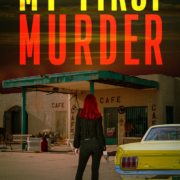The Whack-a-Mole Method of Writing
 By Lois Winston
By Lois Winston
Every author has her own process. What works for one of us doesn’t work for all of us. Some authors are diehard plotters who create extensive outlines before ever committing that first sentence to paper (or in most cases, to keyboard.) Some are known as “pantsers,” authors who write by the seat of their pants, having no more than a vague idea before they place butt in chair and begin pounding out the words.
Some authors set a deadline for each day, whether it’s the amount of time they’ll spend writing or the number of words they’ll write each day. I’ve read about some bestselling, household names who often stop mid-sentence when they reach their day’s word count, or the timer goes off. Other authors will keep writing each day until either their fingers cramp up, their eyes start watering, or their family demands dinner. Often all three.

I’m none of the above. I’m a hybrid—half “pantser” and half whack-a-mole writer. I write in fits and starts. I suppose you could call it the bipolar method of writing. I’m not bipolar, but my writing method certainly is.
The “pantser” part of me comes up with a vague idea for a story. I’ll jot a few sentences or maybe a paragraph or two, which often becomes the basis for back cover copy. But then I give my muse free rein. And that’s where the whack-a-mole writing comes in. Sometimes my muse is extremely cooperative, and my fingers fly across the keyboard for days and days. My word count grows at a frenetic pace. Then, for no apparent reason, the muse deserts me, and I reach a part in the story where I can’t figure out what comes next.
I wrack my brain. I lie awake at night, brainstorming with myself. One night becomes two, then three, then a week. I’m exhausted from lack of sleep, which only makes the situation worse. I spend hours at a time staring at a blinking cursor, waiting for my brain to send a signal to my fingers. I wait and wait and wait.
I check in with my critique partner who offers various suggestions, some with possibilities but none that feel exactly right. I go back and read what I’ve previously written, hoping inspiration will strike, but all I do is wind up tweaking here and there, choosing a more descriptive word, rearranging the sentences in a paragraph. Wasting time.
And then suddenly, my muse returns with a fully formed idea for what happens next. Once again, my fingers fly across the keyboard, my word count soaring.
Until the next time when the pattern repeats itself. Wack-a-mole writing. Love it or hate it, it’s my process, and I’m stuck with it.
~*~
USA Today and Amazon bestselling and award-winning author Lois Winston writes mystery, romance, romantic suspense, chick lit, women’s fiction, children’s chapter books, and nonfiction under her own name and her Emma Carlyle pen name. Kirkus Reviews dubbed her critically acclaimed Anastasia Pollack Crafting Mystery series, “North Jersey’s more mature answer to Stephanie Plum.” In addition, Lois is a former literary agent and an award-winning craft and needlework designer who often draws much of her source material for both her characters and plots from her experiences in the crafts industry. Learn more about Lois and her books at her website www.loiswinston.com where you can also sign up for her newsletter and follow her on various social media sites.








I can certainly see the frustrations, but if it works for you overall, that’s a good thing.
Thanks, Mark! It has so far.
Great description for your writing style. Thanks for sharing, and the image. Funny.
Glad you enjoyed it, M.E.!
I love the metaphor of Whack-a-Mole. Sometimes it describes life itself! Whatever works for you, keep writing. Your characters and readers (including me) are grateful.
Thanks, Saralyn! I have no plans to stop. ;-D
Very entertaining blog, Lois. Thank you for sharing your writing style.
Thanks, Katheryn. Glad you enjoyed it.
An excellent description of how a lot of us write. Thanks for sharing.
Debra, maybe we should form a Whack-a-Mole Writing Club. I had no idea you were also a Whack-a-Moler!
Can we pre-published writers, true Guppies, join your club! Love this concise essay!
Sure, Beth. The more the merrier! Wack-a-Molers of the writing world unite!
I’m glad the process has worked for you as you produce great stories.
Thanks, Dru! You were one of Anastasia’s first fans. I’ve really appreciated your support over the years.
Add me to the whack-a-mole list, Lois. When I was writing Book#2 in my mystery series, I came to a scene that put Samantha in an elevator. It took me a week to decide which other character she would run into when the elevator doors opened, so she stayed inside until the muse returned and I could make a choice.
Gee, Gay, I hope she wasn’t claustrophobic! 😉
Great article, Lois. But answer me this: what do you do when the muse is on a world cruise and you’re stranded? How do you kickstart that next page?
Bye the bye, my Lois Winston coffee mug arrived today. If I rub it, will the muse appear and grant me three pages?
George, the muse is quite temperamental. She only returns when she’s good and ready. However, you could try rubbing the mug. If it works, let me know.
That sounds like me. I’m working on my 14th mystery, and at this point, I’m trying not to take life and my writing process so seriously. Muse or no muse, it always gets done and on time.
Kathleen, a ticking deadline is a great motivator!
I can totally relate to this. Although, sometimes my muse goes in a different direction or comes back with other characters that aren’t supposed to join in. It makes editing a bit more difficult. Yikes.
Jennifer, I’ve learned my muse is usually right, and those different directions usually–but not always–make for a more exciting plot. I can’t speak for everyone else’s muse, though.
This was great fun. Thanks, Stiletto Gang and Lois. One suggestion… maybe this method is best described as Whack-a-MUSE ( ;
Gee, why didn’t I think of that, Pam?
Loved the whack-a-mole analogy. Sounds a lot like my style. Now when I want to whack my empty head, I’ll remind myself that it is simply one approach to writing. Thank you!
You’re welcome, Kathy. I had no idea there were so many other Whack-a-Molers out there!
What do you mean my suggestions don’t feel right. I can attest you’re not bipolar but you’re righting style, downright genius. And this latest book amazing!
Love you, Donnell!!!
Definitely sounds familiar, Lois. I didn’t know there was another way! …Is there?
Not as far as I’m concerned, TK, but I think the plotters out there would disagree.
I love the description of your process. My process is close to yours. I keep two projects going and write on the second one when inspiration fails me on the first project. Sometimes, I ask my characters why or how or jot down possible next steps. I do show up even if I only write a few sentences. If I can’t write new stuff, I update my running outline.-Lynn
I completely empathize with your methodology. As you say, like it or not, it’s yours and you’re sticking to it. Me too. One other thing I do: when an idea strikes in the midst of writing, I’ll stop, make some notes (frequently on the next blank page of the manuscript), then jump back into writing. That way the thoughts remain close until I either work them into the manuscript or delete them because I (my characters and I) have come up with a better idea.